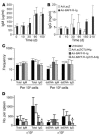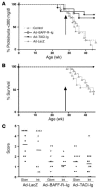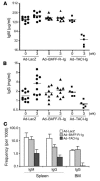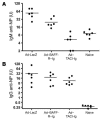Similarities and differences between selective and nonselective BAFF blockade in murine SLE
- PMID: 16485042
- PMCID: PMC1366500
- DOI: 10.1172/JCI26385
Similarities and differences between selective and nonselective BAFF blockade in murine SLE
Abstract
B cells have multiple roles in immune activation and inflammation separate from their capacity to produce antibodies. B cell depletion is currently under intense investigation as a therapeutic strategy for autoimmune diseases. The TNF family members B cell-activating factor of the TNF family (BAFF) and its homolog A proliferation-inducing ligand (APRIL) are B cell survival and differentiation factors and are therefore rational therapeutic targets. We compared the effects of BAFF receptor-Ig, which blocks only BAFF, with those of transmembrane activator and calcium modulator ligand interactor-Ig, which blocks both BAFF and APRIL, in a murine SLE model. Both reagents prolonged the life of NZB/W F1 mice when given either before or after disease onset. Many immunologic effects of the 2 reagents were similar, including B cell and B cell subset depletion and prevention of the progressive T cell activation and dendritic cell accumulation that occurs with age in NZB/W mice without substantial effects on the emergence of the IgG anti-double-stranded DNA response. Furthermore, both reagents inhibited the T cell-independent marginal zone B cell response to particulate antigen delivered i.v., but not the B1 B cell response to the same antigen delivered i.p. In contrast, blockade of both BAFF and APRIL, but not blockade of BAFF alone, reduced the serum levels of IgM antibodies, decreased the frequency of plasma cells in the spleen, and inhibited the IgM response to a T cell-dependent antigen. The differences between selective and nonselective BAFF blockade are relevant to the choice of a BAFF blocking agent for the treatment of autoimmune and malignant diseases.
Figures












References
-
- Lipsky PE. Systemic lupus erythematosus: an autoimmune disease of B cell hyperactivity. Nat. Immunol. 2001;2:764–766. - PubMed
-
- Cassese G, et al. Inflamed kidneys of NZB/W mice are a major site for the homeostasis of plasma cells. Eur. J. Immunol. 2001;31:2726–2732. - PubMed
-
- Takemura S, et al. Lymphoid neogenesis in rheumatoid synovitis. J. Immunol. 2001;167:1072–1080. - PubMed
-
- Mackay F, Schneider P, Rennert P, Browning J. BAFF and APRIL: a tutorial on B cell survival. Annu. Rev. Immunol. 2003;21:231–264. - PubMed
-
- Crowley JE, Treml LS, Stadanlick JE, Carpenter E, Cancro MP. Homeostatic niche specification among naive and activated B cells: a growing role for the BLyS family of receptors and ligands. Semin. Immunol. 2005;17:193–199. - PubMed
Publication types
MeSH terms
Substances
Grants and funding
LinkOut - more resources
Full Text Sources
Other Literature Sources
Medical
Miscellaneous

